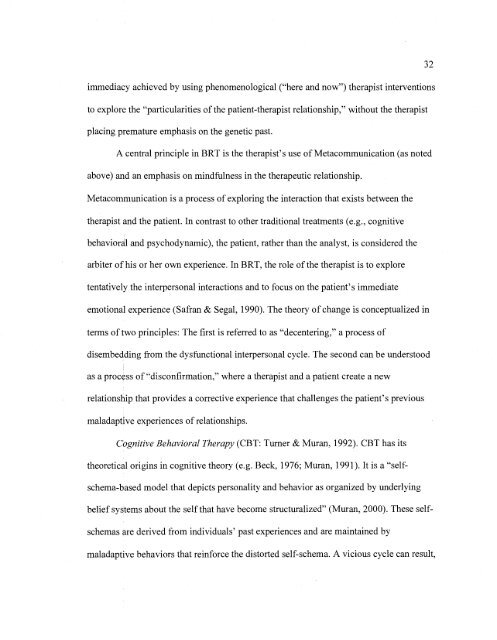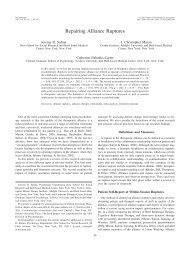Download - The Safran Lab
Download - The Safran Lab
Download - The Safran Lab
Create successful ePaper yourself
Turn your PDF publications into a flip-book with our unique Google optimized e-Paper software.
immediacy achieved by using phenomenological ("here and now") therapist interventions<br />
to explore the "particularities of the patient-therapist relationship," without the therapist<br />
placing premature emphasis on the genetic past.<br />
A central principle in BRT is the therapist's use of Metacommunication (as noted<br />
above) and an emphasis on mindfulness in the therapeutic relationship.<br />
Metacommunication is a process of exploring the interaction that exists between the<br />
therapist and the patient. In contrast to other traditional treatments (e.g., cognitive<br />
behavioral and psychodynamic), the patient, rather than the analyst, is considered the<br />
arbiter of his or her own experience. In BRT, the role of the therapist is to explore<br />
tentatively the interpersonal interactions and to focus on the patient's immediate<br />
emotional experience (<strong>Safran</strong> & Segal, 1990). <strong>The</strong> theory of change is conceptualized in<br />
terms of two principles: <strong>The</strong> first is referred to as "decentering," a process of<br />
disembedding from the dysfunctional interpersonal cycle. <strong>The</strong> second can be understood<br />
as a process of "disconfirmation," where a therapist and a patient create a new<br />
relationship that provides a corrective experience that challenges the patient's previous<br />
maladaptive experiences of relationships.<br />
Cognitive Behavioral <strong>The</strong>rapy (CBT: Turner & Muran, 1992). CBT has its<br />
theoretical origins in cognitive theory (e.g. Beck, 1976; Muran, 1991). It is a "self-<br />
schema-based model that depicts personality and behavior as organized by underlying<br />
belief systems about the self that have become structuralized" (Muran, 2000). <strong>The</strong>se self-<br />
schemas are derived from individuals' past experiences and are maintained by<br />
maladaptive behaviors that reinforce the distorted self-schema. A vicious cycle can result,<br />
32



